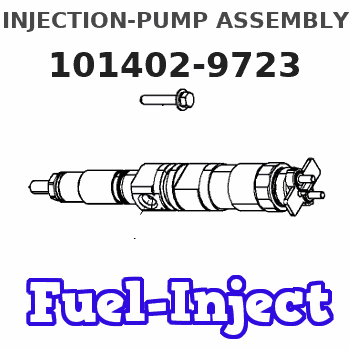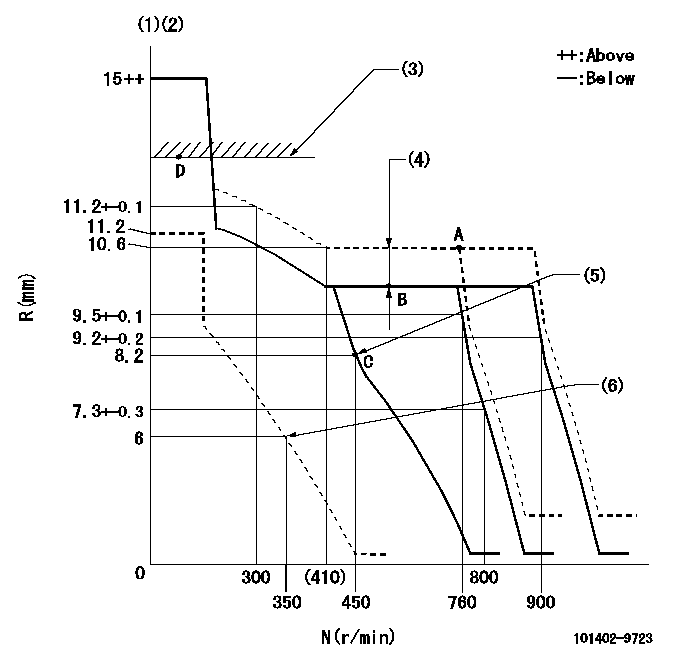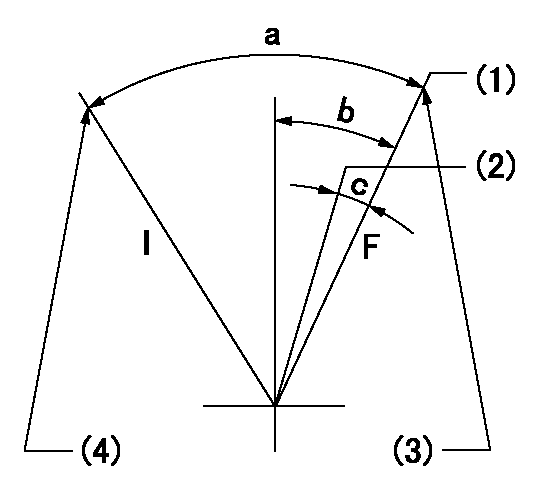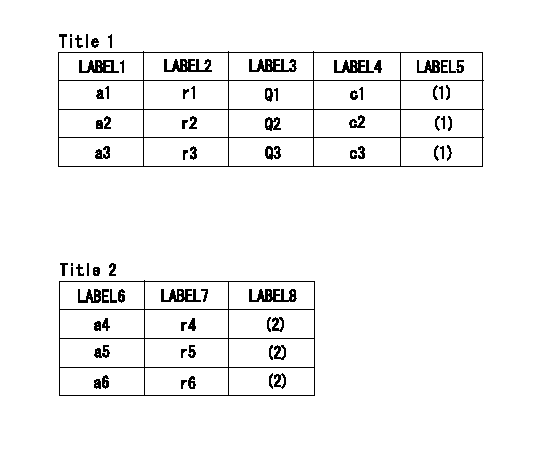Information injection-pump assembly
BOSCH
9 400 611 683
9400611683
ZEXEL
101402-9723
1014029723
NISSAN-DIESEL
1671290206
1671290206

Rating:
Service parts 101402-9723 INJECTION-PUMP ASSEMBLY:
1.
_
5.
AUTOM. ADVANCE MECHANIS
6.
COUPLING PLATE
8.
_
9.
_
11.
Nozzle and Holder
16600-90105
12.
Open Pre:MPa(Kqf/cm2)
18.1{185}
15.
NOZZLE SET
Cross reference number
BOSCH
9 400 611 683
9400611683
ZEXEL
101402-9723
1014029723
NISSAN-DIESEL
1671290206
1671290206
Zexel num
Bosch num
Firm num
Name
101402-9723
9 400 611 683
1671290206 NISSAN-DIESEL
INJECTION-PUMP ASSEMBLY
BD30T K 14BC INJECTION PUMP ASSY PE4A,5A, PE
BD30T K 14BC INJECTION PUMP ASSY PE4A,5A, PE
Calibration Data:
Adjustment conditions
Test oil
1404 Test oil ISO4113 or {SAEJ967d}
1404 Test oil ISO4113 or {SAEJ967d}
Test oil temperature
degC
40
40
45
Nozzle and nozzle holder
105780-8140
Bosch type code
EF8511/9A
Nozzle
105780-0000
Bosch type code
DN12SD12T
Nozzle holder
105780-2080
Bosch type code
EF8511/9
Opening pressure
MPa
17.2
Opening pressure
kgf/cm2
175
Injection pipe
Outer diameter - inner diameter - length (mm) mm 6-2-600
Outer diameter - inner diameter - length (mm) mm 6-2-600
Overflow valve
131424-1520
Overflow valve opening pressure
kPa
157
123
191
Overflow valve opening pressure
kgf/cm2
1.6
1.25
1.95
Tester oil delivery pressure
kPa
157
157
157
Tester oil delivery pressure
kgf/cm2
1.6
1.6
1.6
Direction of rotation (viewed from drive side)
Right R
Right R
Injection timing adjustment
Direction of rotation (viewed from drive side)
Right R
Right R
Injection order
1-3-4-2
Pre-stroke
mm
3.6
3.55
3.65
Beginning of injection position
Drive side NO.1
Drive side NO.1
Difference between angles 1
Cal 1-3 deg. 90 89.5 90.5
Cal 1-3 deg. 90 89.5 90.5
Difference between angles 2
Cal 1-4 deg. 180 179.5 180.5
Cal 1-4 deg. 180 179.5 180.5
Difference between angles 3
Cyl.1-2 deg. 270 269.5 270.5
Cyl.1-2 deg. 270 269.5 270.5
Injection quantity adjustment
Adjusting point
A
Rack position
10.6
Pump speed
r/min
750
750
750
Average injection quantity
mm3/st.
74
73
75
Max. variation between cylinders
%
0
-3.5
3.5
Basic
*
Fixing the lever
*
Boost pressure
kPa
61.3
61.3
Boost pressure
mmHg
460
460
Injection quantity adjustment_02
Adjusting point
C
Rack position
8.2+-0.5
Pump speed
r/min
450
450
450
Average injection quantity
mm3/st.
8
6
10
Max. variation between cylinders
%
0
-10
10
Fixing the rack
*
Boost pressure
kPa
0
0
0
Boost pressure
mmHg
0
0
0
Injection quantity adjustment_03
Adjusting point
D
Rack position
-
Pump speed
r/min
100
100
100
Average injection quantity
mm3/st.
70
70
80
Fixing the lever
*
Boost pressure
kPa
0
0
0
Boost pressure
mmHg
0
0
0
Rack limit
*
Boost compensator adjustment
Pump speed
r/min
500
500
500
Rack position
R1-0.6
Boost pressure
kPa
20
14.7
25.3
Boost pressure
mmHg
150
110
190
Boost compensator adjustment_02
Pump speed
r/min
500
500
500
Rack position
R1(10.6)
Boost pressure
kPa
48
41.3
54.7
Boost pressure
mmHg
360
310
410
Test data Ex:
Governor adjustment

N:Pump speed
R:Rack position (mm)
(1)Target notch: K
(2)Tolerance for racks not indicated: +-0.05mm.
(3)RACK LIMIT
(4)Boost compensator stroke: BCL
(5)Main spring setting
(6)Set idle sub-spring
----------
K=12 BCL=0.6+-0.1mm
----------
----------
K=12 BCL=0.6+-0.1mm
----------
Speed control lever angle

F:Full speed
I:Idle
(1)Set the pump speed at aa. ( At delivery )
(2)When pump speed set at bb
(3)Stopper bolt setting
(4)Stopper bolt setting
----------
aa=900r/min bb=760r/min
----------
a=16deg+-5deg b=6deg+-5deg c=5deg+-5deg
----------
aa=900r/min bb=760r/min
----------
a=16deg+-5deg b=6deg+-5deg c=5deg+-5deg
Stop lever angle

N:Pump normal
S:Stop the pump.
(1)Normal
----------
----------
a=32deg+-5deg b=50deg+-5deg
----------
----------
a=32deg+-5deg b=50deg+-5deg
0000001501 GOV FULL LOAD ADJUSTMENT

Title1:Full load stopper adjustment
Title2:Governor set speed
LABEL1:Distinguishing
LABEL2:Pump speed (r/min)
LABEL3:Ave. injection quantity (mm3/st)
LABEL4:Max. var. bet. cyl.
LABEL5:Remarks
LABEL6:Distinguishing
LABEL7:Governor set speed (r/min)
LABEL8:Remarks
(1)Adjustment conditions are the same as those for measuring injection quantity.
(2)-
----------
----------
a1=A a2=B a3=C r1=750r/min r2=750r/min r3=750r/min Q1=- Q2=74+-1mm3/st Q3=- c1=- c2=+-3.5% c3=- a4=18 a5=15 a6=- r4=900r/min r5=750r/min r6=-
----------
----------
a1=A a2=B a3=C r1=750r/min r2=750r/min r3=750r/min Q1=- Q2=74+-1mm3/st Q3=- c1=- c2=+-3.5% c3=- a4=18 a5=15 a6=- r4=900r/min r5=750r/min r6=-
Timing setting

(1)Pump vertical direction
(2)Position of gear mark 'ZZ' at No 1 cylinder's beginning of injection
(3)B.T.D.C.: aa
(4)-
----------
aa=10deg
----------
a=(100deg)
----------
aa=10deg
----------
a=(100deg)
Information:
Engine Crankshaft Will Not Turn
Possible Causes/Corrections
Low Or No Battery VoltageCheck battery voltage. If battery voltage is less than 8 volts for a 12 volt system, or 16 volts for a 24 volt system, put a charge to the battery. If battery will not hold a charge, load test the battery as shown in the Electrical System of the Testing and Adjusting Section of this Service Manual. Defective Switch, Defective Wiring Or Connection In Swith CircuitWith ignition switch in START position, check voltage at switch connection on starter solenoid. If there is no voltage, or if the voltage is low at this connection, check wiring, connections, ignition switch, and magnetic switch (if used). Defective Cable Or Connection; Battery To StarterWith ignition switch in the START position, check voltage at connection of battery cable to starter. If there is no voltage, or if the voltage is low at this connection and there is good voltage at the battery, check for defective cable or connection between the battery and the starter. Defective Starter SolenoidRemove and repair a solenoid which does not work when voltage is correct at both the battery and ignition switch connections. Defective Starter MotorIf the solenoid works and the starter motor does not turn the crankshaft, the starter motor is defective. Before removing the starter motor, turn the crankshaft by hand to be sure a mechanical failure inside the engine, transmission, or power take-off is not preventing the crankshaft from turning. If crankshaft turns freely by hand, engage the starter motor again. If the starter motor still will not work, remove the starter motor and repair it, or install a new starter motor. Transmission Or Power Take-off (if so equipped) Problem Prevents Crankshaft From TurningIf crankshaft can not be turned by hand, disconnect the transmission and power take-off. If crankshaft will now turn, find the cause of the problem in the transmission or power take-off and make necessary corrections. Inside Problem Prevents Engine Crankshaft From TurningIf the crankshaft can not be turned after disconnecting the transmission and power take-off, remove the fuel nozzles and check for fluid in the cylinders while turning the crankshaft. If fluid in the cylinders is not the problem, the engine must be disassembled to check for other inside problems. Some of these inside problems are bearing seizure, piston seizure, and valves making contact with pistons.Engine Crankshaft Turns Too Slowly
Possible Causes/Corrections
Low Battery VoltageCheck battery voltage. If battery voltage is less than 8 volts for a 12 volt system, or 16 volts for a 24 volt system, put a charge to the battery. If the battery will not hold a charge, load test the battery as shown in the Electrical System of the Testing and Adjusting Section of this Service Manual. Defective Cable Or Connection; Battery To StarterWith switch in START position, check voltage at battery cable connection to starter. If voltage is low at this connection and there is good voltage at the battery, check for defective cable or connection between the battery and
Possible Causes/Corrections
Low Or No Battery VoltageCheck battery voltage. If battery voltage is less than 8 volts for a 12 volt system, or 16 volts for a 24 volt system, put a charge to the battery. If battery will not hold a charge, load test the battery as shown in the Electrical System of the Testing and Adjusting Section of this Service Manual. Defective Switch, Defective Wiring Or Connection In Swith CircuitWith ignition switch in START position, check voltage at switch connection on starter solenoid. If there is no voltage, or if the voltage is low at this connection, check wiring, connections, ignition switch, and magnetic switch (if used). Defective Cable Or Connection; Battery To StarterWith ignition switch in the START position, check voltage at connection of battery cable to starter. If there is no voltage, or if the voltage is low at this connection and there is good voltage at the battery, check for defective cable or connection between the battery and the starter. Defective Starter SolenoidRemove and repair a solenoid which does not work when voltage is correct at both the battery and ignition switch connections. Defective Starter MotorIf the solenoid works and the starter motor does not turn the crankshaft, the starter motor is defective. Before removing the starter motor, turn the crankshaft by hand to be sure a mechanical failure inside the engine, transmission, or power take-off is not preventing the crankshaft from turning. If crankshaft turns freely by hand, engage the starter motor again. If the starter motor still will not work, remove the starter motor and repair it, or install a new starter motor. Transmission Or Power Take-off (if so equipped) Problem Prevents Crankshaft From TurningIf crankshaft can not be turned by hand, disconnect the transmission and power take-off. If crankshaft will now turn, find the cause of the problem in the transmission or power take-off and make necessary corrections. Inside Problem Prevents Engine Crankshaft From TurningIf the crankshaft can not be turned after disconnecting the transmission and power take-off, remove the fuel nozzles and check for fluid in the cylinders while turning the crankshaft. If fluid in the cylinders is not the problem, the engine must be disassembled to check for other inside problems. Some of these inside problems are bearing seizure, piston seizure, and valves making contact with pistons.Engine Crankshaft Turns Too Slowly
Possible Causes/Corrections
Low Battery VoltageCheck battery voltage. If battery voltage is less than 8 volts for a 12 volt system, or 16 volts for a 24 volt system, put a charge to the battery. If the battery will not hold a charge, load test the battery as shown in the Electrical System of the Testing and Adjusting Section of this Service Manual. Defective Cable Or Connection; Battery To StarterWith switch in START position, check voltage at battery cable connection to starter. If voltage is low at this connection and there is good voltage at the battery, check for defective cable or connection between the battery and
Have questions with 101402-9723?
Group cross 101402-9723 ZEXEL
Mitsubishi-Heav
Nissan-Diesel
101402-9723
9 400 611 683
1671290206
INJECTION-PUMP ASSEMBLY
BD30T
BD30T